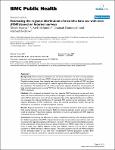Estimating the regional distribution of men who have sex with men (MSM) based on Internet surveys
Marcus, Ulrich
Schmidt, Axel J.
Hamouda, Osamah
Bochow, Michael
Background: Measurement of prevalence and incidence of infections in a hard to reach population like men who have sex with men (MSM) is hampered by its unknown size and regional distribution. Population-based surveys have recently been used to estimate the total number of MSM, but these surveys are usually not large enough to measure regional differences in the proportion of MSM in the population. We explored the use of the proportional regional distribution of participants of large internet-based surveys among MSM from Germany to estimate the regional distribution of MSM in Germany. Methods: We compared participants from two separate MSM behavioural surveys with each other and with the distribution of user profiles of the largest contact and dating website for gay and other MSM in Germany in terms of the representativeness of the regional distribution. In addition, we compared the regional distribution of reportedly HIV positive survey participants with the regional distribution of HIV notifications within the national surveillance system that can be attributed to transmission through homosexual contacts. Results: Regional distribution of survey participants was almost identical in both surveys, despite little overlap between survey participants. Slight discrepancies between surveys and user profiles could be observed. Proportional regional distribution of survey participants with HIV diagnosis resembled national surveillance data. Conclusion: Considering the difficulties to obtain representative data by other sampling methods for "hidden" populations like MSM, internet-based surveys may provide an easy and low cost tool to estimate the regional population distribution – at least in Western post-industrialized countries. Some uncertainties remain about the exact place of residence of MSM in larger cities or catchment areas of these cities. Slightly different results from different datasets may be due to unequal popularity of MSM websites in different regions. The total population size of the MSM population can be estimated based on e.g. data from representative national population surveys. Both estimates can then be combined to calculate the absolute size of regional MSM populations.
Dateien zu dieser Publikation
Keine Lizenzangabe

